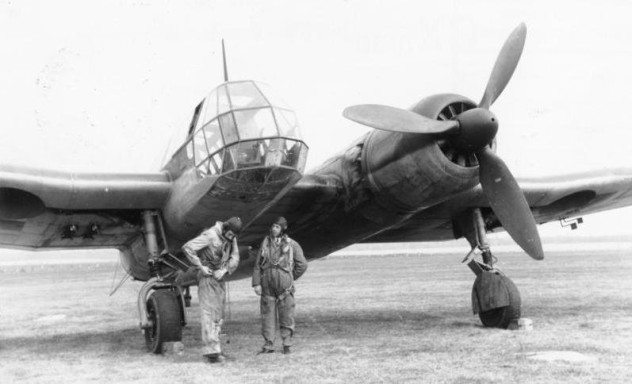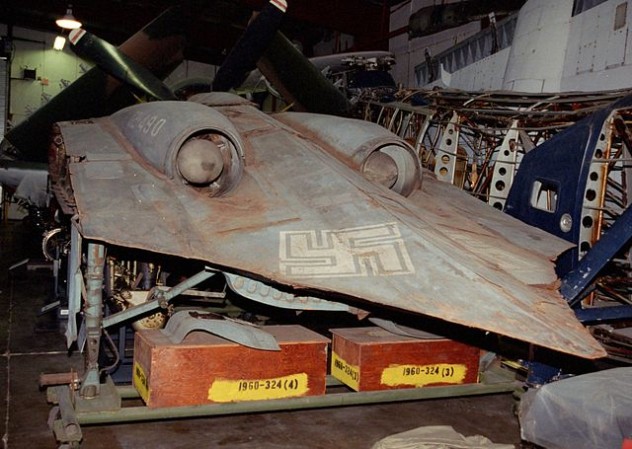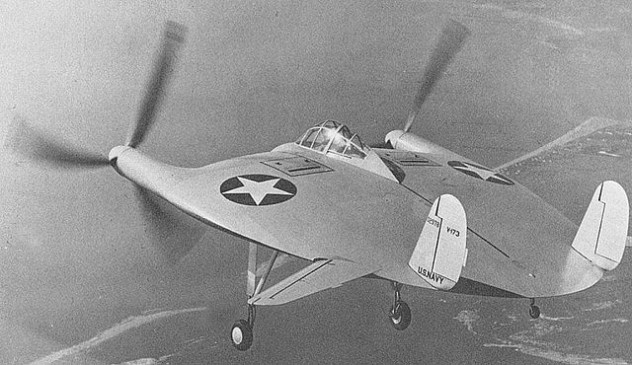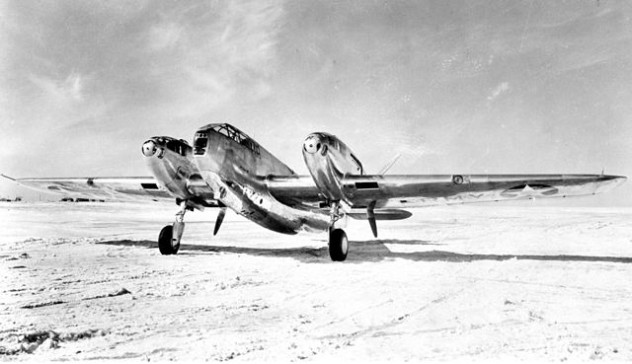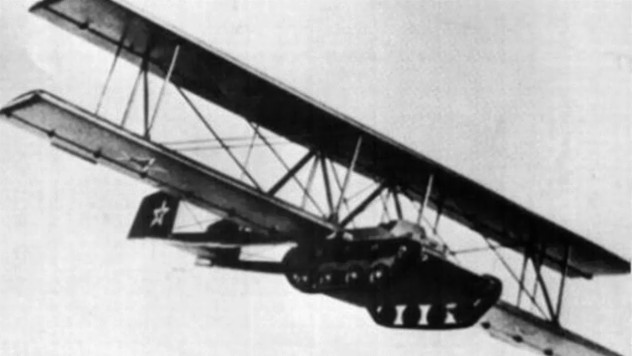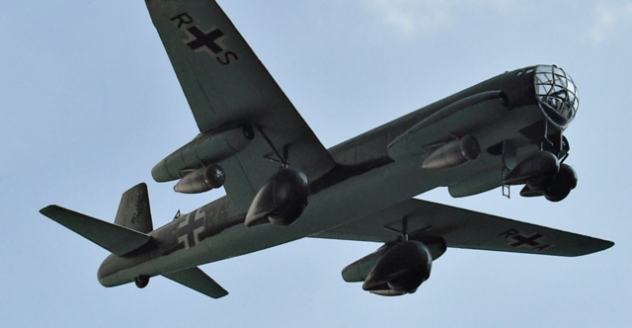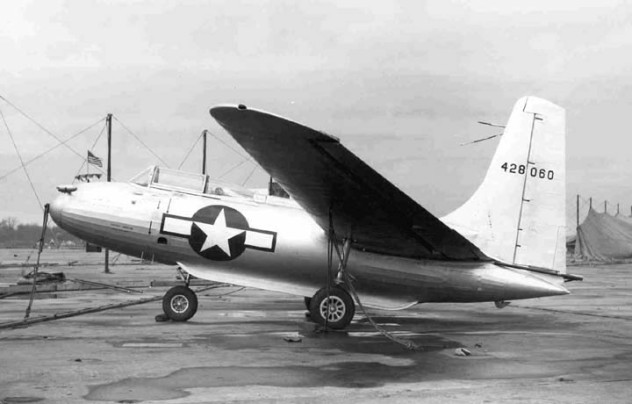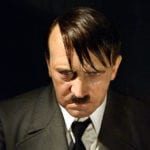10Blohm & Voss BV 141
Early in World War II, the German Air Ministry requested proposals for a tactical reconnaissance aircraft to give intelligence support to army operations. Two companies responded. Focke-Wulf developed a fairly conventional twin-engine aircraft, while Blohm & Voss somehow dreamed up one of the most unconventional aircraft ever created: the asymmetric Bv 141. While the plane’s asymmetric layout seems like an engineer’s fever dream, it did serve a purpose. By clearing up the right side of the aircraft, the Bv 141 offered an unparalleled field of vision for the pilot and observers, especially to the right and to the front, where the pilot was unencumbered by the huge engine and spinning rotors of a conventional single-engine aircraft. The design was actually inspired by designer Richard Vogt’s realization that airplanes of the day had inherently asymmetric handling characteristics anyway. With a large engine in the nose, single-engine aircraft experienced massive amounts of torque, requiring constant attention to keep them under control. By adopting the unusual asymmetric layout, Vogt aimed to offset that torque, creating a stable reconnaissance platform that handled better than many contemporary aircraft. Luftwaffe official Ernst Udet loved the plane when he test-flew it, fast-tracking an order for 500. Unfortunately for Blohm & Voss, an Allied bombing raid severely damaged one of Focke-Wulf’s main factories, prompting the government to convert 80 percent of Blohm & Voss factory space to building Focke-Wulf aircraft. With the company’s already tiny workforce being shifted to Focke-Wulf, work on the Bv 141 was halted after only 38 examples were built. All were destroyed during the war.
9Horten Ho 229
Another unusual Nazi project, the Horten Ho 229 was developed near the end of the war, after German scientists had developed jet technology. By 1943, Luftwaffe commanders realized they had made a huge mistake in choosing not to develop a long-range heavy bomber like the American B-17 or the British Lancaster. To fill this role, Luftwaffe boss Hermann Goering issued the “3×1000” requirement, demanding a bomber that could carry 1,000 kilograms (2,200 lb) of bombs over a range of 1,000 kilometers (620 mi) at a speed of at least 1,000 kilometers per hour (620 mph). Responding to the requirement, the Horten Brothers began designing a flying wing aircraft (a type of aircraft with no tail or distinct fuselage, like later stealth bombers). During the 1930s, the brothers had experimented with flying wing gliders, which showed superior handling characteristics. Using this experience, the brothers built an unpowered glider design as proof of concept for their bomber. The design impressed Goering, who transferred the project to the aircraft company Gothaer Waggonfaebrik for mass production. With some tinkering, the brothers’ glider was given jet propulsion. It was also reworked as a fighter to respond to the Luftwaffe’s need for emergency fighter aircraft in 1945. Only one prototype was built, which was captured by Allied forces as the war ended. Initially, the Ho 229 was simply seen as a curiosity. However, when the B-2 stealth bomber entered service with a similar flying wing design, aerospace experts became curious about the Ho 229’s stealth characteristics. In 2008, engineers at Northrop Grumman created a replica Ho 229 based on the surviving prototype, which is housed at the Smithsonian Institute. Using radar frequencies similar to those developed during World War II, it was discovered that the Ho 229 did in fact have stealth characteristics, with a radar signature much smaller than contemporary fighters. Completely unintentionally, the Horten brothers had created the first stealth fighter.
8Vought V-173/XF5U-1
Starting in the 1930s, Vought engineer Charles H. Zimmerman began experimenting with disk-shaped aircraft. The first flying model was the V-173 (pictured above), which took to the air in 1942. It had problems with the engine gearbox, but overall proved to be a strong, highly maneuverable airframe that was virtually stall-proof. While his company was churning out the famous F4U Corsair, Zimmerman continued to work on a disk-shaped fighter plane, which eventually became known as the XF5U. Navy specifications for the new fighter indicate that it was anticipated to far surpass other aircraft available at the time. Using two huge Pratt & Whitney engines, the fighter was expected to reach a high speed of around 885 kilometers per hour (550 mph), with a landing speed as low as 32 kilometers per hour (20 mph). In order to give the airframe strength while keeping the weight down, the prototype was built with a material called Metalite, which consisted of a thin sheet of balsa wood laminated with aluminum. However, the engines experienced numerous problems, and World War II ended before the aircraft could be fully tested. Vought pursued the project, but by the time it was ready for testing, the Navy had decided to focus on jet aircraft. With the Navy contract gone, Vought attempted to scrap the XF5U, only to find that the Metalite construction refused to be destroyed—dropping a wrecking ball on it only ended with the metal ball bouncing off. After a few more attempts, the airframe finally buckled, and blowtorches were used to burn the rest of it.
7Boulton Paul Defiant
Of all the aircraft on this list, the Boulton Paul Defiant saw the most active service. Unfortunately, that resulted in the deaths of many young airmen. The plane was designed due to a 1930s misunderstanding about how air warfare would develop. British commanders believed that bombers attacking Britain would be largely unescorted and undefended. In theory, a fighter with all of its weapons concentrated in a powered turret would be able to work its way into bomber formations and wreak havoc from the inside. The turret would give a large range of fire while freeing the pilot from the task of gunnery, allowing him to concentrate on putting the aircraft in the optimal firing position. The Defiant did well on its first sorties, since many unsuspecting German fighter pilots misidentified the plane as the similar-looking Hawker Hurricane and attacked from above or from the rear—perfect firing positions for a Defiant gunner. But Luftwaffe pilots quickly learned to avoid attacking Defiants from behind, instead attacking from below or to the front. With no forward-firing weaponry and poor maneuverability due to the heavy turret, Defiant pilots incurred huge losses during the Battle of Britain. Whole fighter squadrons were nearly lost, and Defiant gunners found it impossible to escape the turret in an emergency. Although pilots were able to come up with some stopgap tactics, the RAF quickly realized that the turret fighter was not cut out for modern air combat. The Defiant was relegated to night-fighter squadrons, where it had some success sneaking up and destroying bombers flying night missions. The steady airframe also was used for target practice and to test the first Martin Baker ejection seats.
6Bell YFM-1 Airacuda
In the period between World War I and World War II, the various air powers became more and more concerned about the possibility of strategic bombing in the next war. Italian general Giulio Douhet believed that it was impossible to defend against mass bombing, and British politician Stanley Baldwin coined the phrase “the bomber will always get through.” In response, most major powers invested in designing a “bomber destroyer,” heavy fighters designed to intercept bomber formations. The British Defiant proved unsuccessful, while the German Bf-110 was useful in various roles. And then there was the American YFM-1 Airacuda. The Airacuda was Bell’s first foray into military aircraft design, and it boasted a host of unusual features. In order to give the Airacuda the best chance at destroying enemy aircraft, Bell opted to give it two forward-firing 37-mm M-4 cannons, placed in front of the unusual “pusher” engines and rear-mounted propellers. Each cannon had a dedicated gunner to manually reload its five-round clips. The original plan was for the gunners to actually fire the cannons, using tracer-firing machine guns to help them aim. This was a disaster, and the design was changed to allow the pilot to fire the cannons instead. However, they still had to keep the gunners in order to actually reload the cannons. With defensive machine gun positions on the main fuselage to discourage side attacks, early military strategists believed that the aircraft would be invincible both in intercepting enemy bombers and escorting B-17s over enemy skies. All of these design elements gave the aircraft a distinct bulbous look, similar to a cute cartoon airplane. The Airacuda was a death machine that looked like it was made to cuddle. Despite lofty expectations, testing revealed major problems. The engines were prone to overheating and did not deliver enough thrust. Because of this, the Airacuda actually had a slower top speed than the bombers it was supposed to intercept or defend. The unusual gun positions caused more problems, since they tended to fill up with smoke during firing, rendering the job of the gunners impossible. To make matters worse, gunners would be unable to bail out in an emergency, since the propellers right behind them made escape a death sentence. As a result of these problems, the USAAF only purchased 13 of the aircraft, none of which saw combat service. The remaining airframes were distributed around the country to allow pilots to add the unusual aircraft to their logbooks, and Bell went on to more successful attempts at combat aircraft design.
5Antonov A-40
Although a foreign concept in modern warfare, military gliders were a large part of air strategy in World War II. They were designed to be carried aloft by a tow plane and dropped near enemy territory, allowing supplies and troops to be quickly delivered during airborne operations. Out of all the war’s glider designs, the Soviets produced surely the most unusual: the A-40 flying tank. Most nations looked for ways to get tanks to the front quickly and efficiently. Airlifting them via gliders seemed worth a shot, but engineers soon learned that tanks are some of the least aerodynamic vehicles in existence. After countless attempts to produce a good system for delivering tanks by air, most nations just gave up. But not the Soviet Union. In fact, the Soviet Air Force had already recorded some success with airdropping tanks before they developed the A-40. Small tanks such as the T-27 were lifted aboard large transport planes and dropped a few meters above the ground. If the gearbox was set in neutral, the tank would hit the ground and roll to a stop. The problem was that the tank crew had to drop separately, greatly diminishing the combat effectiveness of the system. The holy grail was to have the tank crew fly the tank to the ground and be in fighting condition within a few minutes. To this end, Soviet planners turned to the ideas of American engineer John Walter Christie, who had originally developed the flying tank concept in the 1930s. With a tank attached to a set of biplane wings, Christie believed that any war would be over quickly, since nobody could defend against a flying tank. Building on Christie’s work, the Soviets mated a T-60 tank with huge biplane wings and ran the first flight test in 1942 with brave (or insane) pilot Sergei Anokhin at the controls. Although the drag from the tank forced the tow plane to ditch the glider before reaching the goal altitude, Anokhin was able to land smoothly and even drove the tank back to base. While Anokhin gave an enthusiastic report, the concept was ditched after the Soviets realized that they lacked planes powerful enough to tow an operational tank (Anokhin had flown with most of the tank’s weaponry and fuel discarded). Sadly, the idea of a flying tank never got off the ground again.
4Junkers Ju-287
As Allied bombing missions undermined the German war effort, Luftwaffe commanders realized that their reluctance to develop any multi-engined heavy bombers had been a huge mistake. As the brass began issuing orders for heavy bombers, most German aircraft manufacturers jumped at the opportunity. This included the Horten Brothers (as mentioned above) and Junkers, who already had experience in creating bombers. Junkers engineer Hans Wocke led the design on arguably the most forward-thinking German aircraft of World War II: the Ju-287. Engineers in the ’30s realized that an aircraft with a straight wing would have an inherent upper speed limit, but at the time it was of no concern, since propeller engines couldn’t get anywhere close to the limit anyway. However, with the advent of jet technology, everything changed. German aircraft designers used swept wings on early jet aircraft such as the Me-262, which avoided the air compression issues inherent in straight wing design. Wocke took this one step further and proposed an aircraft with a forward-swept wing, which he believed would be able to outrun any air defenses. This new type of wing had many advantages: increased maneuverability at high speeds and high angles of attack, better stall characteristics, and clearing the fuselage for weaponry and engines. Wocke’s design was originally intended as an aerodynamic test bed, with many of the components taken from other airplanes, including captured Allied bombers. During test flights, the Ju-287 performed excellently, meeting all the proposed performance characteristics. Unfortunately for Wocke, interest in a fast jet bomber waned and his design was shelved until March 1945. By that point, desperate Luftwaffe commanders were searching for any new design that could damage the Allies, and production was quickly started on the Ju-287, only for the war to end two months later after only a few prototypes had been built. It would take another 40 years for forward-swept wings to begin seeing renewed popularity with American and Russian aerospace engineers.
3Cornelius XFG-1
George Cornelius was an engineer known for a variety of eccentric glider and airplane designs. During the ’30s and ’40s, he tinkered with new types of aircraft layouts, including a number of experiments with forward-swept wings (as on the Ju-287). His gliders had excellent stall characteristics and could be towed at high speeds without causing significant drag on the tow plane. When World War II broke out, Cornelius was recruited to design the XFG-1, one of the most specialized aircraft ever produced. In essence, the XFG-1 was a flying fuel tank. Cornelius planned to have both manned and unmanned versions of his glider, both of which could be towed by contemporary bombers at their cruising speed of 400 kilometers per hour (250 mph), twice the speed most other gliders could manage. In its unmanned form, the XFG-1 was a revolutionary concept. B-29s would tow the unmanned glider behind them with hoses providing fuel transfer to the mother aircraft. With a storage capacity of 764 gallons, the XFG-1 would act as a flying drop tank. As soon as the fuel tank was empty, the B-29 would jettison the glider, which would then drift down to the ground and crash. This system would greatly increase the range of B-29 bombers, allowing raids on Tokyo and other Japanese cities. The manned form was similar, but supposedly less wasteful, in that it allowed the glider to land rather than simply crashing once the fuel was used up, although one has to wonder what pilot would sign up for the task of flying a fuel tank over a dangerous combat zone. Testing was marred by the deadly crash of one of the prototypes, and the concept fell out of favor as Allied forces captured islands closer to the Japanese mainland. With closer airbases, B-29 missions would not need extra fuel to reach their targets, rendering the XFG-1 obsolete. After the war, Cornelius continued to propose his concept to Air Force commanders, but by that time the focus had shifted toward dedicated air-refueling tanker aircraft. The XFG-1 simply became an obscure footnote in Air Force history.
2Zveno-SPB
The idea of a flying aircraft carrier was first envisioned during World War I and experimented with during the interwar period. At the time, military engineers dreamed of a large airship with small parasite fighters capable of leaving the mothership to defend it against intercepting enemy aircraft. British and American tests ended in disaster, and the idea was dropped altogether as the diminishing tactical value of large rigid airships became clear. But just as the British and Americans were discontinuing their experiments, the Soviet Air Force (VVS) was just starting. In 1931, aviation engineer Vladimir Vakhmistrov proposed using large Tupolev bombers to carry smaller fighters into the air. This gave the fighters a significantly increased range and allowed them to carry larger bomb loads than usually possible when configured for dive-bombing. Without the bombs, the fighters would also be able to defend the Tupolevs against enemy interceptors. Throughout the 1930s, Vakhmistrov experimented with various configurations, reaching the point where he was attaching five fighter planes to one bomber aircraft. By the start of World War II, Vakhmistrov had scaled back his ideas to a more practical design with two I-16 fighter-bombers attached to a TB-3 mothership. Soviet high command was sufficiently impressed with the concept to attempt using it operationally. The first raid against a Romanian oil depot was successful, with both fighters decoupling and conducting the raid before returning to a Soviet forward base. After that initial success, 30 raids were conducted, the most famous of which was the destruction of a bridge near Chernovodsk in August 1941. The Soviets had attempted to destroy the bridge for months with no success until they decided to use two of Vakhmistrov’s monstrosities. Both planes launched their fighters, which proceeded to destroy the previously untouchable bridge. Despite these successes, the Zveno project was shuttered a few months later and the planes were retired when all Soviet I-16 and TB-3 aircraft were removed from frontline service in favor of more advanced designs. Thus ended the career of one of the strangest—yet successful—aviation concepts in history.
1Fieseler Fi-103R
Most people are familiar with the Japanese kamikaze missions, which used older aircraft laden with explosives as anti-shipping weapons. They even designed a purpose-built kamikaze rocketplane called the MXY-7. Less well known is the German attempt to build a similar weapon by modifying V-1 flying bombs into piloted flying missiles. With the war coming to an end, the Nazi top brass were desperate for a way to disrupt Allied shipping over the English Channel. V-1 rockets had potential, but the need for actual accuracy (never their strong suit) necessitated a manned version. Using existing V-1 fuselages, German engineers were able to install a small cockpit just ahead of the jet engine, as well as very basic controls for the pilot. Unlike the V-1 rockets, which were launched from the ground, Fi-103R piloted missiles were meant to be carried into the air and launched from He-111 bombers. Once the missile was launched, the pilot would need to visually acquire his target, aim his aircraft at the ship, and then bail out. Unlike their Japanese counterparts, German pilots would not be sealed into their cockpits and were expected to attempt escaping. However, with a roaring engine directly behind the canopy, bailing out would probably be fatal anyway. These slim chances of pilot survival gave Luftwaffe commanders a bad impression of the program, and no operational missions were ever carried out. However, 175 V-1 missiles were still converted into Fi-103Rs, most of which fell into Allied hands at the end of the war. I am a physics student who writes on the side. Check out my blog at zacherybrasier.com and follow me on Instagram and Twitter. I might post interesting things.
